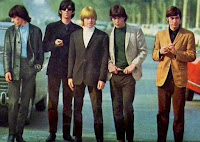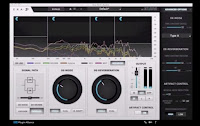One of the more iconic songs of the last century is "Satisfaction" by The Rolling Stones. Every guitar player learns the famous Keith Richards lick when learning how to play, and every garage band plays the song sometime during their career.
The problem is that it's never played quite right since the arrangement is difficult to hear through a distorted final mix.
Today's isolated track is a real treat in that it features the very clean instrumental-only track of "Satisfaction" where you'll hear some things you probably never noticed before.
The instrumentation includes Keith Richards on electric guitar, Brian Jones on acoustic, Bill Wyman on bass, Charlie Watts on drums, and arranger Jack Nitzsche on piano and tambourine. Here's what to listen for:
1. The acoustic rhythm guitar really pushes the song along. In the final mix it blends into the track but the song would have a much different feel if it wasn't there.
2. Speaking of blending in, the piano also fills out the rhythm section and is pretty imperceptible on the final mix. You can hear it best on the verses.
3. Listen to what happens during the drum breakdown. Charlie Watts continues to play the same beat as he did in the rest of the song while the signature rhythm hook is played by the tambourine (which is also played during the rest of the song). The number of cover bands that get this right is about zero, although maybe the way we think we hear it is the way it should have been played in the first place.
4. Listen to high tight the band is. The timing is excellent, a trait that would get sloppier as the years went on.
Help Support This Blog
Friday, August 21, 2015
Thursday, August 20, 2015
What's The Best Driving Music?
 An Israeli research endeavored to answer the question "What's the best driving music?" and found the answer. The problem is, it's not one that you'll like.
An Israeli research endeavored to answer the question "What's the best driving music?" and found the answer. The problem is, it's not one that you'll like.Psychology professor Warren Brodsky of Ben-Gurion University discovered that the answer is none, or at least none that's good for you!
It turns out that music is a major distraction for all drivers, especially if it's a song you like or one that frequently changes tempo and volume. Any music with a beat that gets you drumming on your steering wheel increases your potential for drifting into a different lane without you noticing. An old favorite can get you reminiscing about the past, while something that you've never heard before can make you concentrate more on the lyrics than your driving.
Probably none of you reading this are going to give up music in the car for talk radio, so what's the solution?
Brodsky suggest unfamiliar music with a steady tempo but no lyrics, so I guess that means we'll all be listening to smooth jazz in our cars soon, or not.
If you're interested in reading the study, the findings were published in his book "Driving With Music: Cognitive-Behavioral Implications."
Wednesday, August 19, 2015
A Description Of Each Frequency Band In A Single Word
One of the things I've found over the years is that it's easy to interpret the demands of a client during a mix if you understand what they're trying to get across. It's amazing how just a single word can describe a frequency condition if we know what to listen for.
Here's a chart from The Mixing Engineer's Handbook 3rd edition that describes each frequency band with just a single word (along with some alternates).
Here's a chart from The Mixing Engineer's Handbook 3rd edition that describes each frequency band with just a single word (along with some alternates).
You can read more from The Mixing Engineer's Handbook and my other books on the excerpt section of bobbyowsinski.com.
Labels:
book excerpt,
EQ,
frequency bands,
mixing engineers handbook
Tuesday, August 18, 2015
A Look At A Record Groove Through An Electron Microscope
OK, this is just plain cool. Last week we looked at a guitar string playing in real time, today we'll take a closeup look at the groove of a record with an electron microscope.
As an added bonus, you'll also get a closeup look at a CD and video disc, as well as a terrific explanation of what's happening by Ben Krasnow from his Applied Science blog. This is a lot more complicated than you think.
As an added bonus, you'll also get a closeup look at a CD and video disc, as well as a terrific explanation of what's happening by Ben Krasnow from his Applied Science blog. This is a lot more complicated than you think.
Labels:
Ben Krasnow,
CD,
electron microscope,
video,
video disc,
vinyl record
Monday, August 17, 2015
Producer/Music Director Rob Shrock On My Latest Inner Circle Podcast
On the latest episode of my Inner Circle Podcast I'm pleased to have musician/producer/music director Rob Shrock as my guest.
Rob has played with a host of A-listers including Stevie Wonder, Elton John, and Adele, and has served as musical director for music legends Burt Bacharach and Dionne Warwick, and for the 72nd Academy Awards Show.
You might also be familiar with Rob through his articles in Keyboard, Electronic Musician, Mix and Remix magazines.
In the intro I discuss the new QuickHitz radio format that many artists so despise, as well as the 6 things I always bring to a session.
Remember that you can find the podcast at BobbyOInnerCircle.com, or either on iTunes or Stitcher.
Rob has played with a host of A-listers including Stevie Wonder, Elton John, and Adele, and has served as musical director for music legends Burt Bacharach and Dionne Warwick, and for the 72nd Academy Awards Show.
You might also be familiar with Rob through his articles in Keyboard, Electronic Musician, Mix and Remix magazines.
In the intro I discuss the new QuickHitz radio format that many artists so despise, as well as the 6 things I always bring to a session.
Remember that you can find the podcast at BobbyOInnerCircle.com, or either on iTunes or Stitcher.
New Music Gear Monday: Accusonics ERA-D Noise And Reverb Remover
While everyone likes to think that their recordings are as clean as possible, sometimes we're faced with fixing one that's either noisy or has more reverb in it than we'd like. It can get expensive when it comes to specialized plugins to fix noise or reverb problems, and sometimes the learning curve is steep to get the results you want and need.
Enter the Accusonus ERA-D de-noise and de-reverberation plugin, an easy to use plugin that's effective and won't cost you an arm and a leg.
The ERA-D has two large controls to set the amount of de-noise and de-reverb, and also features 4 modes of operation - de-noise only, de-reverb only, cascade where the signal passes through the de-noise and then the de-reverb, and parallel where the signal passes through both at the same time.
Additional controls allow you to tweak the results including noise time constant, processing time constant and three types of selectable noise reduction. There are also separate reverb time constant controls for both low and high frequencies and an advanced artifact control.
One of its best features is a hi-res display that shows frequency, noise, reverb, and dry and processed signals. There are also 4 adjustable bands for adjustment of de-noise and de-reverb, which are all linkable.
The Accusonus ERA-D is available for Mac or Windows platforms and in AAX native, AU, VST2 and VST3 formats. It's available with a 14 day free trial for $299 at the plugin-alliance.com.
Enter the Accusonus ERA-D de-noise and de-reverberation plugin, an easy to use plugin that's effective and won't cost you an arm and a leg.
The ERA-D has two large controls to set the amount of de-noise and de-reverb, and also features 4 modes of operation - de-noise only, de-reverb only, cascade where the signal passes through the de-noise and then the de-reverb, and parallel where the signal passes through both at the same time.
Additional controls allow you to tweak the results including noise time constant, processing time constant and three types of selectable noise reduction. There are also separate reverb time constant controls for both low and high frequencies and an advanced artifact control.
One of its best features is a hi-res display that shows frequency, noise, reverb, and dry and processed signals. There are also 4 adjustable bands for adjustment of de-noise and de-reverb, which are all linkable.
The Accusonus ERA-D is available for Mac or Windows platforms and in AAX native, AU, VST2 and VST3 formats. It's available with a 14 day free trial for $299 at the plugin-alliance.com.
Labels:
Accusonus ERA-D,
de-noise,
de-reverberation,
New Music Gear Monday,
plugin,
plugin alliance,
video
Subscribe to:
Comments (Atom)






